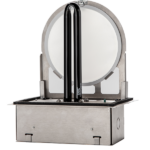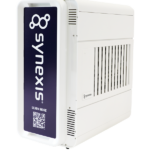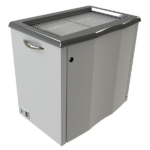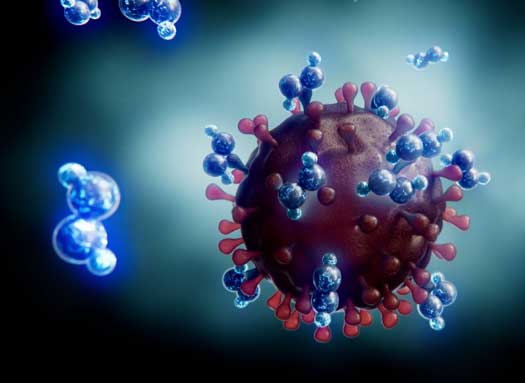Publications
Explore Peer-Reviewed Articles
About Synexis Dry Hydrogen Peroxide (DHP ®)
Mitigating COVID-19 Transmission in Long-Term Care: A Facility’s Experience with Dry Hydrogen Peroxide14
Published February 2025 in American Journal of Infection Control.
Following a successful pilot study in which Dry Hydrogen Peroxide (DHP) significantly reduced environmental bioburden in a long-term care facility in New York state, DHP deployment was expanded into additional facility units to mitigate environmental infection transmission. The presence or absence of DHP notably impacted a subsequent COVID-19 outbreak initiated by staff and propagated by resident interactions.
The Effect of Dry Hydrogen Peroxide on Environmental Contamination with Candida auris in an Adult Burn Unit13
Published November 2023 in Open Forum Infectious Diseases.
Candida auris (C. auris) is an emerging multi-drug resistant pathogen that is a health threat for hospitalized patients. C. auris may survive on surfaces where standard disinfectants may not achieve adequate disinfection. Continuous dry hydrogen peroxide (DHP) reduces microbial bioburden on surfaces and may reduce the risk of C. auris transmission in the clinical care setting.
Effectiveness of Dry Hydrogen Peroxide in Reducing Air and Surface Bioburden in a Multicenter Clinical Setting12
Published November 2023 in Infection Control & Hospital Epidemiology.
DHP has the potential to reduce microbial air and surface bioburden in occupied patient rooms with standard ventilation parameters.
Utilizing Dry Hydrogen Peroxide as a Replacement for Formaldehyde in Commercial Poultry Hatcheries11
Published October 2023 in U.S Poultry & Egg Association.
Hatchery sanitation is a continual issue in commercial poultry and has become a focus since the removal of antibiotics in production. Poor sanitation leads to reduced hatchability, increased 3- and 7-day mortality, and chronic infections that can reduce performance. More than 30 years ago, using a formaldehyde fogging system in hatchers was a common practice to control microbes. But as the undesirable effects on equipment, chick respiratory quality and hatchery workers were realized, the practice was discontinued in many places. Now, with reduction in antibiotic use, formaldehyde fogging has again become a common practice.
Effect of Dry Hydrogen Peroxide on Candida Auris Environmental Contamination10
Published September 2023 in Antimicrobial Stewardship & Healthcare Epidemiology.
Candida auris is an emerging pathogen that exhibits broad antimicrobial resistance and causes highly morbid infections. Prolonged survival on surfaces has been demonstrated, and standard disinfectants may not achieve adequate disinfection. Persistent patient colonization and constant environmental recontamination poses an infection risk that may be mitigated by no touch disinfection systems. We evaluated the efficacy of continuous dry hydrogen peroxide (DHP) exposure on C. auris environmental contamination.
Impact of Dry Hydrogen Peroxide on Environmental Bioburden Reduction in a Long-Term Care Facility9
Published June 2023 in American Journal of Infection Control.
Environmental infection transmission is a perennial problem in long-term care facilities (LTCFs), exacerbated by shared living arrangements, residents with cognitive deficits, staffing shortages, and suboptimal cleaning and disinfection. This study evaluates the impact of dry hydrogen peroxide (DHP), as a supplement to manual decontamination, on bioburden within an LTCF neurobehavioral unit.
Impact of Dry Hydrogen Peroxide on Hospital-Acquired Infection at a Pediatric Oncology Hospital8
Published December 2021 in American Journal of Infection Control.
This study aims to describe the effect of DHP, as an adjunct to environmental cleaning and disinfection, on the incidence of hospital-acquired infections (HAIs) at Unidad Nacional de Oncologia Pediatrica (UNOP) in Guatemala City, Guatemala.
Treatment with Dry Hydrogen Peroxide Accelerates the Decay of Severe Acute Syndrome Coronavirus-2 on Non-porous Hard Surfaces7
Published July 2021 in American Journal of Infection Control.
Disinfection of contaminated or potentially contaminated surfaces has become an integral part of the mitigation strategies for controlling coronavirus disease 2019. In this study, the feasibility of using DHP in inactivating SARS-CoV-2 on contaminated surfaces in large indoor spaces was evaluated.
An Effective and Automated Approach for Reducing Infection Risk from Contaminated Privacy Curtains6
Published June 2021 in American Journal of Infection Control.
There is limited information on how to reduce levels of curtain contamination while they are in use and between changings. Here we describe the outcome of using DHP to reduce levels of contamination on privacy curtains used in different areas of the hospital.
Evaluation of Dry Hydrogen Peroxide in Reducing Microbial Bioburden in a Healthcare Facility5
Published March 2021 in American Journal of Infection Control.
Standard manual cleaning and disinfection practices are often inadequate. Persistent contamination in the environment poses an infection risk that may be mitigated by no-touch disinfection systems. This study evaluates the efficacy of DHP on microbial air and surface contamination as an adjunct to routine cleaning and disinfection in a large urban hospital.
Infection Specialists and Pharmacists Share Responsibility for Ensuring Patient Safety4
Published November 2020 in Pharmacy Times.
Effects of a Dry Hydrogen Peroxide Disinfection System Used in an Egg Cooler on Hatchability and Chick Quality3
Published November 2020 in Poultry Science.
A sanitation method that could continually clean and disinfect the air and surfaces in a hatchery could provide a second layer of microbial reduction on top of routine cleaning and disinfection. A gaseous dry hydrogen peroxide (DHP®) system has been used in other facilities for this purpose and could have potential for use in chicken hatchery.
Effectiveness of Dry Hydrogen Peroxide on Reducing Environmental Microbial Bioburden Risk in a Pediatric Oncology Intensive Care Unit2
E-published August 2020 in American Journal of Infection Control.
Routine manual cleaning and disinfection of the health care environment is often suboptimal. Residual contamination poses an infection risk, particularly for immunocompromised patients. This study evaluates the efficacy of dry hydrogen peroxide DHP on microbial surface contamination in a pediatric oncology intensive care unit.
Dilute Hydrogen Peroxide Technology for Reduction of Microbial Colonization in the Hospital Setting1
Published June 2015 in American Journal of Infection Control.
It is estimated that hospital-acquired infections (HAIs) cost US hospitals over $30 billion annually. Dilute hydrogen peroxide (DHP) technology is a new patented technology that utilizes ambient air to produce hydrogen peroxide as a near-ideal gas, creating concentrations of peroxide that are well below the Environmental Protection Agency safety thresholds. In laboratory testing, DHP has demonstrated potent disinfective activity against a variety of bacteria, fungi, and viruses.
References: 1. Herman CK, Hess J, Cerra C. Dilute hydrogen peroxide technology for reduction of microbial colonization in the hospital setting. Abstract only. Am J Infect Control. 2015;43(6):S25-S26. https://doi.org/10.1016/j.ajic.2015.04.064. 2. Ramirez M, Matheu L, Gomez M, et al. Effectiveness of dry hydrogen peroxide on reducing environmental microbial bioburden risk in a pediatric oncology intensive care unit. Am J Infect Control. 2021;49(5):608-613. Epub 2020 Aug 20. https://doi:10.1016/j.ajic.2020.08.026 3. Melo, E.F, McElreath, J.S, Wilson, J.L.C, Lara, Cox, N.A, Jordan, B.J, (2020). Effects of a Dry Hydrogen Peroxide Disinfection System Used in an Egg Cooler on Hatchability and Chick Quality. Science Direct. https://www.sciencedirect.com/science/article/pii/S0032579120303692 4. Kaiser, Creighton PharmD, Roe, Anna M. MSN, RN, (2020). Infection Specialists and Pharmacists Share Responsibility for Ensuring Patient Safety. Pharmacy Times. https://www.pharmacytimes.com/view/infection-specialists-and-pharmacists-share-responsibility-for-ensuring-patient-safety 5. Sanguinet J, Edmiston C. Evaluation of dry hydrogen peroxide in reducing microbial bioburden in a healthcare facility. Am J Infect Control. 2021;49(8):985-990. https://doi:10.1016/j.ajic.2021.03.004 6. Sanguinet J, Lee C. An effective and automated approach for reducing infection risk from contaminated privacy curtains. Am J Infect Control. 2021;49(10):1337-1338. https://doi:10.1016/j.ajic.2021.06.004 7. Huang YS, Bilyeu AN, Hsu WW, et al. Treatment with dry hydrogen peroxide accelerates the decay of severe acute syndrome coronavirus-2 on non-porous hard surfaces. Am J Infect Control. 2021;49(10):1252-1255. https://doi:10.1016/j.ajic.2021.07.006 8. Melgar M, Ramirez M, Chang A, Antillon F. Impact of dry hydrogen peroxide on hospital-acquired infection at a pediatric oncology hospital [published online ahead of print, 2021 Dec 29]. Am J Infect Control. 2021;S0196-6553(21)00851-8. https://doi:10.1016/j.ajic.2021.12.010 9. Cole, Mary, Impact of dry hydrogen peroxide on environmental bioburden reduction in a long-term care facility. Am J Infect Control. 2023 June. https://doi.org/10.1016/j.ajic.2023.06.004 10. Jennifer Sanguinet, Gerard Marchall, Julia Moody, and Kenneth Sands, Effect of dry hydrogen peroxide on Candida auris environmental contamination. Cambridge University Press. 2023 September. https://www.cambridge.org/core/journals/antimicrobial-stewardship-and-healthcare-epidemiology/article/effect-of-dry-hydrogen-peroxide-on-candida-auris-environmental-contamination/ED82D581233B948EF82392450FB73EF3 11. Brian J. Jordan, Ph.D. Utilizing Dry Hydrogen Peroxide as a Replacement for Formaldehyde in Commercial Poultry Hatcheries. U.S Poultry & Egg Association. November 13, 2023. https://www.uspoultry.org/programs/research/search-abstracts/repository/PROJ_727.html 12.Wright D, Christie J, Lawrence J, Vaughn KL, Walsh TF. Effectiveness of dry hydrogen peroxide in reducing air and surface bioburden in a multicenter clinical setting. Infection Control & Hospital Epidemiology. 2023:1-8. doi:10.1017/ice.2023.153 https://www.cambridge.org/core/journals/infection-control-and-hospital-epidemiology/article/effectiveness-of-dry-hydrogen-peroxide-in-reducing-air-and-surface-bioburden-in-a-multicenter-clinical-setting/81ACA92F8FBF92AB0D1D2463FF020798 13. Jared Alan Sutton, Nychie Dotson, Jaquelyn Nagy, Julia Moody, Kenneth E Sands, 1418. The Effect of Dry Hydrogen Peroxide on Environmental Contamination with Candida auris in an Adult Burn Unit, Open Forum Infectious Diseases, Volume 10, Issue Supplement_2, December 2023, ofad500.1255, https://doi.org/10.1093/ofid/ofad500.1255 14.Cole, R., MS, CNRN, CCRN, SCRN, CIC. (2025, February). Mitigating COVID-19 Transmission in Long-term Care: A Facility’s Experience with Dry Hydrogen Peroxide. American Journal of Infection Control. https://www.ajicjournal.org/article/S0196-6553(25)00053-7/fulltext










